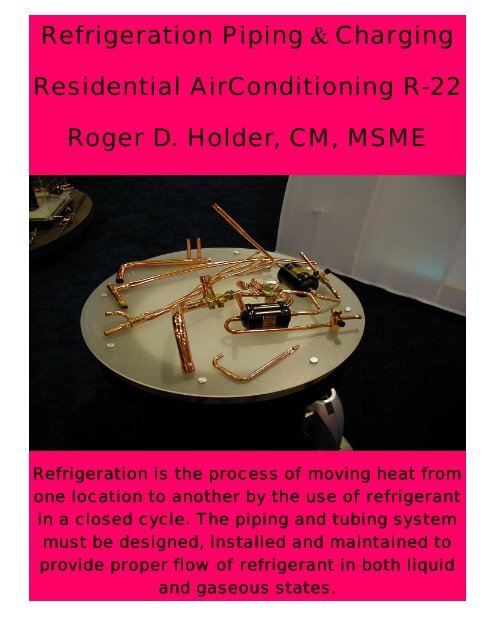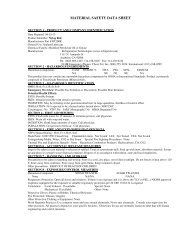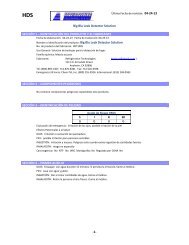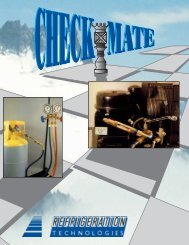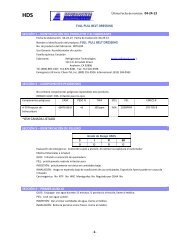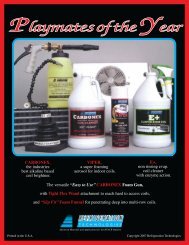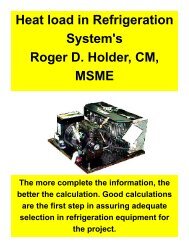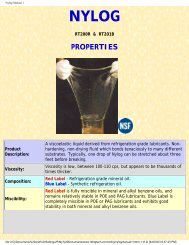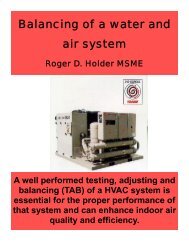Refrigeration Piping Charging Residential AirConditioning R
Refrigeration Piping Charging Residential AirConditioning R
Refrigeration Piping Charging Residential AirConditioning R
You also want an ePaper? Increase the reach of your titles
YUMPU automatically turns print PDFs into web optimized ePapers that Google loves.
<strong>Refrigeration</strong> <strong>Piping</strong> & <strong>Charging</strong><br />
<strong>Residential</strong> <strong>AirConditioning</strong> R-22<br />
Roger D. Holder, CM, MSME<br />
<strong>Refrigeration</strong> is the process of moving heat from<br />
one location to another by the use of refrigerant<br />
in a closed cycle. The piping and tubing system<br />
must be designed, installed and maintained to<br />
provide proper flow of refrigerant in both liquid<br />
and gaseous states.
2<br />
2
<strong>Piping</strong> & Tubing<br />
3<br />
<strong>Refrigeration</strong> <strong>Piping</strong><br />
<strong>Refrigeration</strong> is the process of moving heat from one location to another by the use of<br />
refrigerant in a closed cycle. The piping and tubing system must be designed, installed and<br />
maintained to provide proper flow of refrigerant in both liquid and gaseous states. A<br />
successful refrigeration system depends on a good piping design and an understanding of the<br />
required accessories. The first skill that any refrigeration apprentice mechanic learns is to<br />
make a soldered joint. Running pipe is so common a task that its critical importance in system<br />
performance is often overlooked.<br />
Tubing Inspection & Leak Check<br />
The object of a good visual inspection of system tubing design is to note obvious oil traps.<br />
Also look for long vertical suction lengths without p traps and inadequate OD tubing size If the<br />
system is known to be leaking or if oil is present around mechanical fittings, solder joints,<br />
gaskets or seals, recover the refrigerant and repair the leaks. Pressurize the system with a<br />
residual amount of refrigerant and dry nitrogen using the recommended test pressure on data<br />
plate. Maximum test pressures should be approximately 150 psi for high-pressure AC/R<br />
systems. In chiller applications, controlled hot water or heater blankets will raise pressure<br />
adequately for a leak check, which should never exceed 10 psi for low pressure chillers. After<br />
a thorough inspection with a good leak detector, apply a deep vacuum to 500 microns. A good<br />
triple evacuation, with dry nitrogen and then deep vacuum is the preferred method.<br />
<strong>Piping</strong> Basic Principles<br />
<strong>Refrigeration</strong> piping involves extremely complex relationships in the flow of refrigerant and oil.<br />
Fluid flow is the study of the flow of a gas or a liquid, and the inter-relationship of velocity,<br />
pressure, friction, density and the work required to cause the flow. The design of a<br />
refrigeration piping system is a continuous series of compromises. It is desirable to have<br />
3
4<br />
maximum capacity at minimum cost, as well as proper oil return. Since oil must pass through<br />
the compressor cylinders to provide lubrication, a small amount of oil is always circulating<br />
with the refrigerant. Oil and refrigerant vapor, however, do not mix readily, and the oil can be<br />
properly circulated through the system only if the mass velocity of the refrigerant vapor is<br />
great enough to sweep the oil along. To ensure oil circulation adequate velocities of<br />
refrigerant must be maintained in the suction and discharge lines, and in the evaporator.<br />
The design of refrigerant piping systems should:<br />
• Ensure proper refrigerant feed to evaporators.<br />
• Provide practical refrigerant line sizes without excessive pressure drop.<br />
• Prevent excessive amounts of lubricating oil from being trapped in any part of the system.<br />
• Protect the compressor at all times from loss of lubricating oil.<br />
• Prevent liquid refrigerant or oil slugs from entering the compressor during operating and<br />
idle time.<br />
• Maintaining a clean and dry system.<br />
Refrigerant Line Velocities<br />
Economics, pressure drop, noise, and oil entrapment require establishing feasible design<br />
velocities in refrigerant lines.<br />
• Suction line 700 to 4000 fpm<br />
• Discharge line 500 to 3500 fpm<br />
• Condenser drain line 100 fpm or less<br />
• Liquid line 125 to 450 fpm<br />
Higher gas velocities are sometimes found in relatively short suction lines, on comfort air<br />
conditioning or other applications where the operating time is only 2000 to 4000 hours per<br />
year and where low initial cost of the system may be more significant than low operating cost.<br />
In the Industrial refrigeration applications where equipment runs continuously, should be<br />
designed with low refrigerant velocities for most efficient compressor performance and low<br />
equipment operating cost. Care must be taken that the velocities is not to low that oil is taped<br />
in the refrigeration lines.<br />
Liquid line from condenser to receivers should be sized for 100 fpm or less to ensure positive<br />
4
5<br />
gravity flow without incurring backup of liquid flow. Liquid lines from receivers to evaporator<br />
should be sized to maintain velocities below 300 fpm, thus minimizing or preventing liquid<br />
hammer when solenoids or other electrically operated valves are used.<br />
Refrigerant Line Sizing<br />
In sizing refrigerant lines, cost considerations favor keeping line size as small as possible.<br />
However, suction and discharge line pressure drops cause loss of compressor capacity and<br />
increased power use. Excessive liquid line pressure drops can cause the liquid refrigerant to<br />
flash, resulting in faulty expansion valve operation. <strong>Refrigeration</strong> systems are designed so that<br />
friction pressure losses do not exceed a pressure differential equivalent to a corresponding<br />
change in the saturation boiling temperature. The primary measure for determining pressure<br />
drop is a change in saturation temperature. Pressure drop in refrigerant lines causes a<br />
reduction in system efficiency. Correct sizing must be based on minimizing cost and<br />
maximizing efficiency. Pressure drop calculations are determined as normal pressure loss<br />
associated with a change in saturation temperature of the refrigerant. Typically, the<br />
refrigeration system will be sized for pressure losses of 2ºF or less for each segment of the<br />
discharge, suction, and liquid lines. An HFC refrigerant liquid line is sized for pressure losses<br />
of 1ºF or less.<br />
Discharge lines should be designed to:<br />
• Avoid trapping oil at part-load operation.<br />
• Prevent condensed refrigerant and oil from draining back to the head of the compressor.<br />
• Have carefully selected connections from a common line to multiple compressors.<br />
• Avoid developing excessive noise or vibration from hot-gas pulsation, compressor<br />
vibration, or both.<br />
When sizing discharge lines, considerations similar to those applied to the suction line are<br />
observed. Pressure loss in discharge lines increases the required compressor power per unit<br />
of refrigeration and decreases the compressor capacity by increasing the compression ratio.<br />
While the discharge line pressure drop is not as critical as that of the suction line, the<br />
accepted maximum values are 4 psi for R-12 and 6 psi for R-22. The same minimum gas<br />
velocities of 500 feet per minute in horizontal runs and 1000 feet per minute in vertical runs<br />
with upward gas flow are observed. The maximum acceptable gas velocity, based on noise<br />
considerations, is 4000 feet per minute.<br />
5
Condenser Drain Line<br />
6<br />
The line between a condenser (not providing liquid subcooling) and a liquid receiver, when<br />
such an arrangement is used, must be carefully sized. While it is almost impossible to oversize<br />
such a line, under sizing is to be avoided. An undersized line can restrict the flow of refrigerant<br />
to the extent that some of it is held in the condenser. If some of the condenser surface is<br />
flooded, the capacity is reduced. These causes the head pressure to rise and decrease the<br />
overall system capacity. At the same time, the power to drive the compressor rises.<br />
There are a few points that the piping designer should keep in mind.<br />
• Condenser drain line velocity should be 100 fpm or less.<br />
• The distance from the condenser to receiver should be as short as possible.<br />
• The condenser must be located above the receiver.<br />
• If the system is equipped with an air-cooled condenser and a liquid receiver, it is good<br />
practice to locate the receiver within the building. Some means should be provided to isolate<br />
the receiver from the condenser during cold weather shutdown, such as a combination check<br />
and relief valve.<br />
Receiver<br />
Refrigerant receivers are vessels used to store excess refrigerant while still allowing<br />
circulation throughout the system. Receivers perform the following functions:<br />
• Provide pumpdown storage capacity when another part of the system must be serviced or<br />
the system must be shut down for an extended time. In some water-cooled condenser<br />
systems, the condenser also serves as a receiver if the total refrigerant charge does not<br />
exceed its storage capacity.<br />
• Handle the excess refrigerant charge that occurs with air-cooled condensers using the<br />
flooding type condensing pressure control.<br />
• Accommodate a fluctuating charge in the low side.<br />
• Drain the condenser of liquid.<br />
• Maintain an adequate affective condensing surface on system where the operating charge in<br />
the evaporator and or condenser varies for different loading conditions. When an evaporator is<br />
fed with a thermal expansion valve, hand expansion valve, or low-pressure float, the operating<br />
charge in the evaporator varies considerably depending on the loading. During low load, the<br />
evaporator requires a larger charge since the boiling is not as intense. When the load<br />
6
7<br />
increases, the operating charge in the evaporator decreases, and the receiver must store<br />
excess refrigerant.<br />
• Hold the full charge of the idle circuit on systems with multicircuit evaporators that shut off<br />
the liquid supply to one or more circuits during reduced load.<br />
Receiver Design Considerations<br />
• Receiver should be close to the condenser.<br />
• If there is any doubt about the line size, use the larger of the sizes.<br />
• Always adhere to the minimum vertical dimension required to overcome friction.<br />
• Install a pressure relief device on top of each receiver and on condenser.<br />
• The surge receiver pressure relief device is piped together with condensers.<br />
• Size the receiver to hold 40 to 125% of refrigerant charge depending on system load<br />
variance.<br />
When a through type receiver is used, the liquid must always flow from the condenser to the<br />
receiver. The piping must provide free flow of liquid from the condenser to the receiver by<br />
equalizing the pressure between the two. If a vent is not used, the piping between condenser<br />
and receiver is sized so that liquid flows in one direction and gas flows in the opposite<br />
direction. Sizing the condensate drain line for 100 fpm liquid velocity is usually adequate to<br />
attain this flow. <strong>Piping</strong> should slop at least 0.25 in/ft and eliminate any natural liquid traps. The<br />
condensate drain line should be sized so that the velocity does not exceed 100 fpm.<br />
Please consult the manufacturer’s literature for making receiver capacity comparisons when<br />
changing refrigerants.<br />
Liquid Lines<br />
Pressure drop should not be so large as to cause gas formation in the liquid line or insufficient<br />
liquid pressure at the liquid feed device. Systems are normally designed so that the pressure<br />
drop in the liquid line, due to friction, is not greater than that corresponding to about a 1º to<br />
2ºF change in saturation temperature.<br />
Pressure drop (in psig) for a change of 1ºF saturation at 100ºF condensing<br />
pressure: (R-508B is at 10ºF):<br />
7
8<br />
Liquid subcooling is the only method of overcoming the liquid line pressure losses in<br />
order to guarantee liquid at the expansion device in the evaporator. If the subcooling is<br />
insufficient, flashing will occur within the liquid line and degrade the efficiency of the<br />
system. Friction pressure drops in the liquid line are caused by accessories such as<br />
solenoid valves, filter driers, and hand valves, as well as by the piping and fittings<br />
between the receiver outlet and the refrigerant feed device at the evaporator. Liquid<br />
line risers are also a source of pressure loss. The loss due to a riser is approximately<br />
0.556 psi per foot of liquid lift. The total loss is the sum of all friction losses plus the<br />
pressure loss from liquid risers. <strong>Refrigeration</strong> systems that have no liquid risers and<br />
have the evaporator below the condenser and/or receiver benefit from a gain in<br />
pressure due to liquid weight. They can thus tolerate larger friction losses without<br />
flashing. When flashing occurs, the overall efficiency is reduced and the system may<br />
malfunction. The only way to reduce the effect of pressure loses and friction is by<br />
subcooling the refrigerant.<br />
Suction Lines<br />
Suction lines are more critical than liquid and discharge line from a design and<br />
construction standpoint. They should be designed to:<br />
• Provide a minimum pressure drop at full load.<br />
• Return oil from the evaporator to the compressor under minimum load conditions.<br />
• Prevent oil from draining from an active evaporator into an idle one.<br />
A pressure drop in the suction line reduces a system’s capacity by forcing the<br />
compressor to operate at a lower suction pressure, in order to maintain a desired<br />
evaporating temperature in the coil. As the suction pressure is decreased, each pound<br />
of refrigerant returning to the compressor occupies a greater volume, and the weight<br />
of the refrigerant pumped by the compressor decreases. For example, a typical low<br />
8
9<br />
temperature R-502 compressor at -40ºF evaporating temperature will lose almost 6% of<br />
its rated capacity for each 1 psi suction line pressure drop. Normally accepted design<br />
practice is to use a suction line pressure drop equivalent to a 2ºF change in saturation<br />
temperature.<br />
Of equal importance in sizing the suction line is the necessity of maintaining adequate<br />
velocities to properly return oil to the compressor. Studies have shown that oil is most<br />
viscous in a system after the suction vapor has warmed up a few degrees from the<br />
evaporating temperature, so that the oil is no longer saturated with the refrigerant.<br />
This condition occurs in the suction line after the refrigerant vapor has left the<br />
9
10<br />
evaporator.<br />
Movement of the oil through suction lines is dependent on both the mass and velocity<br />
of the suction vapor. As the mass or density decreases, higher velocities are required<br />
to force the oil along.<br />
Nominal minimum velocities of 700 fpm in horizontal suction lines and 1500 fpm in<br />
vertical suction lines have been recommended and used successfully for many years<br />
as suction line sizing design standards. Use of the one nominal velocity provided a<br />
simple and convenient means of checking velocities. However, tests have shown that<br />
in vertical risers the oil tends to crawl up the inner surface of the tubing, and the larger<br />
the tubing, the greater velocity required in the center of the tubing to maintain tube<br />
surface velocities that will carry the oil. The exact velocity required in the vertical line<br />
is dependent on both the evaporating temperature and the line size, and under varying<br />
conditions, the specific velocity required might be either greater or less than 1500 fpm.<br />
An HFC refrigerant, however, is designed for 1500 fpm or greater.<br />
Always pitch vapor lines in the direction of flow, 1/2 inch per ten-foot of suction line.<br />
“P” traps for uphill oil return should be used after the first 6- foot and every 12-foot<br />
thereafter. It is good practice to use an inverted trap just before entering the<br />
compressor.<br />
Double Risers<br />
On systems equipped with capacity control compressors, or where tandem or multiple<br />
compressors are used with one or more compressor cycled off for capacity control, a<br />
single suction line riser may result in either unacceptably high or low gas velocities. A<br />
line properly sized for light load conditions may have too high a pressure drop at<br />
maximum load, and if the line is sized based on full load condition, then velocities may<br />
not be adequate conditions to move oil through the tubing at light load. On air<br />
conditioning applications where somewhat higher pressure drops at maximum load<br />
conditions can be tolerated without any major penalty in overall system performance,<br />
it is usually preferable to accept the additional pressure drop imposed by a single<br />
vertical riser. However, on medium or low temperature applications where pressure<br />
10
11<br />
drop is more critical and where separate risers from individual evaporators are not<br />
possible, a double riser may be necessary to avoid an excessive loss of capacity.<br />
A typical double riser has a small and large riser. The two should be sized so that the<br />
total cross-sectional area is equivalent to the cross-section area of a single riser that<br />
would have both satisfactory gas velocity and acceptable pressure drop at maximum<br />
load conditions. The larger is trapped and the smaller line must be sized to provide<br />
adequate velocities and acceptable pressure drop when the entire minimum load is<br />
carried in the smaller riser.<br />
Another method of suction oil return is the use of a double riser, as shown<br />
in Figure 1. Oil return is accomplished with this method at minimum loads. In addition,<br />
excessive pressure drop at full load is avoided. The small riser “A” is sized to return<br />
oil under minimum capacity conditions. Riser “B” which, may be larger, is sized so<br />
pressure drop through both risers during full load conditions is adequate. Traps with<br />
minimum oil holding capacity are recommended.<br />
11
12<br />
Suction Line Double Risers Sizing<br />
Single Riser Size Double Riser Sizes 2/3, 1/3<br />
1 1/8 = .83 7/8 and 3/4 = .83<br />
1 3/8 = 1.26 1 1/8 and 7/8 = 1.31<br />
1 5/8 = 1.78 1 3/8 and 7/8 = 1.74<br />
2 1/8 = 3.10 1 5/8 and 1 3/8 = 3.04<br />
2 5/8 = 4.77 2 1/8 and 1 5/8 = 4.88<br />
3 1/8 = 6.81 2 5/8 and 1 5/8 = 6.55<br />
Defrost Gas Supply Lines<br />
Sizing refrigeration lines to supply defrost gas to one or more evaporator is an<br />
estimate at best. The parameters associated with sizing the defrost gas lines are<br />
related to allowable pressure drop and refrigerant flow rate during defrost. Design<br />
professionals typically use approximately two times the evaporator load for effective<br />
refrigerant flow rate to determine line-sizing requirements. The pressure drop is not as<br />
critical during the defrost cycle, and many engineers have used velocity as criterion<br />
for determining line size. The effective condensing temperature and average<br />
temperature of the gas must be determined. The velocity determined at saturated<br />
conditions will give a conservative line size. It is recommended that initial sizing be<br />
based on twice the evaporator flow rate and that velocities from 1000 to 2000 fpm be<br />
used for determining the defrost gas supply line size.<br />
Refrigerant Line Capacity Tables & Equivalent Lengths Of Valves & Fittings<br />
Refrigerant line capacity tables are based on unit pressure drop per 100 ft length of<br />
straight pipe or per combination of straight pipe, fitting, and valves with friction drop<br />
equivalent to a 100 ft length of straight pipe. Generally, pressure drop through valves<br />
and fittings is determined by establishing the equivalent straight length of pipe of the<br />
same size with the same friction drop. Alternately, one rule of thumb is to add 50% to<br />
the calculated pipe length to account for pressure drops from fittings and valves.<br />
12
13<br />
Expansion & Contraction<br />
Temperature change will expand and contract all refrigeration piping material.<br />
Techniques must allow for expansion and contraction changes to prevent stresses<br />
that may buckle, bend or rupture the refrigerant piping. he two common methods of<br />
taking care of expansion and contraction in copper piping are the “expansion loops”<br />
or “pipe offsets”. During the installation of the line, care must be taken that the line<br />
maintains a perfect alignment.<br />
On average, copper’s coefficient of expansion is 0.0000104 inch per inch per degree<br />
Fahrenheit. Thus, expansion of copper is 1.25 inch per 100 feet per 100ºF change. For<br />
example, a copper compressor discharge line of 75 feet long at 225ºF could have a<br />
temperature change of 150ºF in a 70ºF room. Therefore, 1.25 X 1.55 (temperature<br />
change per 100ºF) X .75 (length per 100 feet) will equal 1.453 inches of expansion. The<br />
75 foot long line would now be approximately 75 feet, 1-1/2 inches long.<br />
Location & Arrangement of <strong>Piping</strong><br />
Refrigerant lines should be as short and direct as possible to minimize tubing and<br />
refrigerant requirements and pressure drops. Plan piping for a minimum number of<br />
joints, using as few elbows and other fitting as possible, but provide sufficient<br />
flexibility to absorb compressor vibration and stresses due to thermal expansion and<br />
contraction.<br />
13
14<br />
Arrange refrigerant piping so that normal inspection and servicing of the compressor<br />
and other equipment is not hindered. Do not obstruct the view of the oil level sight<br />
glass, or run piping so that it interferes with the removal of compressor cylinder head,<br />
end bells, access plates, or any internal parts. Suction line piping to the compressor<br />
should be arranged so that it will not interfere with removal of the compressor for<br />
servicing.<br />
You must provide adequate clearance for insulation installation between the piping,<br />
wall, and hangers. Use sleeves that are sized to permit installation of both pipe and<br />
insulation through floor, walls, or ceilings. Set the sleeves prior to pouring of concrete<br />
or erection of brickwork. <strong>Piping</strong> must not interfere with passages or obstruct<br />
headroom, windows, or doors. Refer to ASHRAE Standard 15, Safety Code for<br />
Mechanical <strong>Refrigeration</strong>, and other governing local codes for restrictions that may<br />
apply.<br />
Protection Against Damage To <strong>Piping</strong><br />
Protection against damage is necessary, particularly for small lines, which have a false<br />
appearance of strength. Where traffic is heavy, provide protection against impact from<br />
pedestrian and motorized traffic.<br />
<strong>Piping</strong> Insulation<br />
All piping joints and fittings should be thoroughly leak tested before insulation is<br />
sealed. Suction lines should be insulated to prevent sweating and heat gain. Insulation<br />
covering lines on which moisture can condense or lines subjected to outside<br />
conditions must be vapor sealed to prevent any moisture travel through the insulation,<br />
or condensation in the insulation. Although the liquid line ordinarily does not require<br />
insulation, the suction and liquid lines can be insulated together. The liquid line should<br />
be insulated to minimize heat gain if it passes through an area of higher temperature.<br />
Hot gas discharge lines usually are not insulated, however, they should be insulated if<br />
the heat dissipated is objectionable or if necessary to prevent injury from high<br />
temperature surfaces.<br />
14
15<br />
Vibration & Noise in <strong>Piping</strong><br />
Two undesirable effects of vibration of refrigerant piping are: 1) physical damage to<br />
the piping, which may result in the breaking of brazed joints and consequent loss of<br />
charge; and 2) transmission of noise through the piping itself and through building<br />
construction with which the piping may come into direct physical contact. Both can be<br />
eliminated or minimized by proper piping design and installation.<br />
Using Manufacturer’s Pressure Drop & Velocity Charts<br />
Always size for pressure drop first, then velocity. On the top right of the pressure drop<br />
chart in Figure 8-3, you will find tons of refrigeration or cooling capacity calibrated in<br />
Btu per hour up to 1 ton, and in tons of cooling from 1 ton to 100 tons. You start the<br />
sizing procedure by drawing a straight line from your system’s designated capacity<br />
through the diagonal lines on the right side of the chart.<br />
The diagonal lines represent:<br />
• The “evaporator temperature”, used to size the suction line.<br />
• The “discharge line” temperature, used to size the hot gas discharge.<br />
• The “liquid lines” diagonal line, used to size the liquid line.<br />
15
16<br />
The diagonal lines on the left of the chart represent the actual tubing sizes that will be<br />
derived by your calculation. Starting at the bottom line, representing 3/8" OD Type L<br />
copper tubing and increasing in size up through 6-1/8. Draw a horizontal line from each<br />
intersection of tonnage and each of the three diagonal lines, horizontally across<br />
through the tubing sizes.<br />
On the bottom left of the chart you will find the “pressure drop graph.” The three<br />
horizontal lines represent condenser coil temperature applications. The curved<br />
diagonal lines are pressure drop in psi per 100 ft. When you have determined<br />
necessary condenser coil temperature follow the horizontal line to the required<br />
pressure drop. Draw a line straight up until it intersects with the horizontal line used to<br />
determine tubing size. If it falls in between two sizes then your size is the tubing size<br />
up and to the left. For example, let’s size for a 6-ton R-134a medium temperature walkin<br />
refrigerator using the chart in your book:<br />
16
17<br />
• First, find 6 tons on the top right of your chart and draw a vertical line straight down<br />
through all of the diagonal lines.<br />
Medium temperature requires a 20°F evaporator so draw a line from the diagonal line<br />
designated 20°F horizontally all the way across the chart.<br />
• Do the same from the diagonal line labeled “Discharge Line.”<br />
• And again from the diagonal line labeled “Liquid Line.”<br />
The suction line pressure drop maximum for medium temperature is 1-1/2 psi so the<br />
suction line size will be 1-5/8". We require a 3psi pressure drop for our liquid line so<br />
the line size is 5/8". The hot gas discharge line is a bit more forgiving, 10 psi or less,<br />
so 1-1/8" will work adequately. The velocity chart is very similar to the pressure drop<br />
chart and is used in the same way. The idea is to confirm the sizes you found on the<br />
pressure chart by cross checking with the applicable velocities on the velocity chart. If<br />
you plot the same temperature variables on the velocity chart, you’ll find the sizes<br />
chosen will fall between minimum and maximum velocities recommended for each<br />
refrigeration line. There are exceptions and sometimes economical compromises on<br />
many close-coupled and field fabricated systems. It is these exceptions that may need<br />
careful consideration before retrofit.<br />
17
18<br />
18
19<br />
19
20<br />
20
21<br />
21
22<br />
22
23<br />
23
24<br />
24
25<br />
25
26<br />
404A<br />
26
27<br />
27
28<br />
402A<br />
28
29<br />
29
30<br />
30
31<br />
31
32<br />
32
33<br />
<strong>Charging</strong> <strong>Residential</strong> Air Conditioning R-22<br />
Different types of metering devices have different ways of charging. A Thermostatic<br />
Expansion Valve (TXV) is charged to the subcooling of the liquid line leaving the<br />
condenser. A fixed orifice is charged to the superheat of the suction line leaving the<br />
evaporator. To under stand why this is, it requires an understanding of the physical<br />
properties of the refrigeration cycle. The four main components of the refrigeration<br />
cycle include:<br />
• Compressor<br />
• Condenser<br />
• Metering Devices<br />
• Evaporator<br />
These four components are divided into sections and explained in depth as follows.<br />
Compressor<br />
The Compressor compresses a low-pressure superheated gas into a high-pressure<br />
superheated gas. If the suction gas is not superheated, the compressor can be<br />
damaged. The compressor pulls the refrigerant out of the evaporator and pushes it<br />
though a condenser. The act of compression is performed by any one of the following<br />
six types of compressors: a reciprocating piston, rotary, scroll, screw, centrifugal, and<br />
sonic compressors. Of the six, the reciprocating and scroll compressors are the two<br />
most frequently found in a residential air conditioning system.<br />
The mass flow rate produced by a compressor is equal to the mass of the suction gas<br />
pulled in by the compressor. The compressor’s out put is equally only to its intake<br />
because the mass flow must be equal. The process of compression, through mass<br />
flow, raises the temperature and pressure of the refrigerant. The result of the<br />
temperature increase is superheat. Pressure and temperature of the refrigerant must<br />
be higher than the condensing temperature. The refrigerant temperature must be<br />
33
34<br />
higher so heat can flow into the condensing medium. This process explains the<br />
necessary relationship between the increased pressure and the rise in temperature. If<br />
the pressure and temperature is not increased through compression, there is no heat<br />
transferred from the refrigerant to the condensing medium. The compressor has a<br />
maximum inlet temperature of about 70° degrees and outlet of about 225° degrees.<br />
Inlet refrigerant gas cools the compressor motor.<br />
Desuperheating (heat leaving the refrigerant gas) of refrigerant begins as it is<br />
discharged. From a compressor and pushed into a condenser.<br />
Condenser<br />
The condenser removes heat and changes a high-pressure vapor into a high-pressure<br />
liquid. As the superheated (high-pressure) gas is pushed into the condenser, it is<br />
desuperheated, that is the temperature is reduced to saturated pressure-temperature.<br />
The refrigerant does not start to change state until the temperature reaches saturated<br />
pressure-temperature. The only variable that can change the temperature is a<br />
pressure change. (See table 1) At saturation pressure-temperature point, the change<br />
of state becomes latent heat (invisible or hidden heat). Latent heat is a lack of rise or<br />
fall of temperature during a change of state (saturation). When the temperature does<br />
not rise or fall it is at saturation and the change of state process begins. Refrigerant<br />
continues to change state at one pressure-temperature. The only variable that can<br />
change a temperature is a pressure change. If a temperature change occurs a<br />
pressure change occurs. If a pressure change occurs a temperature change occurs.<br />
At the change of state the refrigerant liquid and vapor are at the same temperature.<br />
This is defined as equilibrium contact. The temperatures of the liquid and vapors will<br />
stay the same until the temperature of the refrigerant starts to drop. Temperature of<br />
the refrigerant start to drop once 98% to 99% of the refrigerant becomes a liquid. This<br />
is called subcooling. Subcooling is a temperature below saturated pressuretemperature.<br />
(See table 1) Subcooling is a measurement of how much liquid is in the<br />
condenser. In air conditioning, it is important to measure subcooling because the<br />
longer the liquid stays in the condenser, the greater the sensible (visible) heat loss.<br />
34
35<br />
Low subcooling means that a condenser is empty. High subcooling means that a<br />
condenser is full. Over filling a system increases, pressure due to the liquid filling of a<br />
condenser that shows up as high subcooling. To move the refrigerant from<br />
condenser to the liquid line, it must be pushed down the liquid line to a metering<br />
device. If a pressure drop occurs in the liquid line and the refrigerant has no<br />
subcooling, the refrigerant will start to re-vaporize (change state from a liquid to a<br />
vapor) before reaching the metering devise.<br />
Refrigerant –22<br />
Liquid line<br />
Saturated temperate - Temperature = subcooling<br />
200 psig = 101 degrees - 96 degrees = 5 degrees<br />
210 psig = 105 degrees - 90 degrees = 15 degrees<br />
240 psig = 114 degrees - 98 degrees = 16 degrees<br />
(Table 1)<br />
Metering Devices<br />
A metering device is a pressure drop point, which has two jobs:<br />
1. Holds refrigerant back in a condense; and<br />
2. Feeds refrigerant into the evaporator.<br />
When high-pressure liquid enters a metering device, pressure starts to drop, as the<br />
temperature remains the same until it reaches saturation pressure-temperature. At<br />
this time both the pressure and temperature continues to drop to evaporator pressuretemperature.<br />
(See table 2) Low-pressure liquid that is leaving the metering device is<br />
boiling at saturated pressure-temperature. The process of a refrigerant changing its<br />
state (from a liquid to a vapor) in the metering device is called flash gas. Flash gas is<br />
what cools the refrigerant liquid in the metering device. A system with no subcooling<br />
35
has more gas that is flashed and less capacity.<br />
36<br />
Evaporators<br />
The refrigerant enters the evaporator as a boiling low-pressure liquid at saturated<br />
pressure-temperature. It continues to boil at one temperature as long as the pressure<br />
remains the same. If there is not a pressure change in the evaporator, there will not be<br />
a temperature change in the refrigerant changing state. At saturation, refrigerant<br />
absorbs latent heat, which is a change of state heat. The refrigerant changes state at<br />
one temperature (for any one pressure) from the beginning of the evaporator until the<br />
entire liquid refrigerant has become a vapor. The only variable that can change a<br />
temperature is a pressure change. If a temperature change occurs a pressure change<br />
occurs. In latent heat, the liquid and vapor are at the same temperature due to<br />
equilibrium contact. When heat is added to the gas, past saturation pressuretemperature,<br />
it is called superheat. (See Table 2) Superheat is an indication of how full<br />
the evaporator is of liquid refrigerant. High superheat means the evaporator is empty.<br />
Low superheat means the evaporator is full. There have been reports that liquid<br />
refrigerant can still be boiling with 2° degrees of superheat. Superheat should never<br />
be observed below 4° degrees or a compressor failure may occur. The superheat gas<br />
is pulled into the compressor were it starts the cycle again.<br />
Refrigerant –22<br />
suction line<br />
Saturated temperate - Temperature = superheat<br />
58 psig = 32 degrees - 44 degrees = 12 degrees<br />
64 psig = 37 degrees - 47 degrees = 10 degrees<br />
70 psig = 41 degrees - 50 degrees = 9 degrees<br />
(Table 2)<br />
36
<strong>Charging</strong> Methods<br />
37<br />
Before charging of a residential air conditioning system, two temperatures must be<br />
recorded:<br />
1. Condensing air inlet dry bulb temperature.<br />
2. Evaporator air inlet wet bulb temperature. Wet bulb temperature is a measurement<br />
of the heat contained within air. Air may have many different wet bulb temperatures<br />
for one dry bulb temperature, depending on relative humidity of the air.<br />
Different types of metering devices have different ways of charging.<br />
Thermostatic Expansion Valve R-22<br />
A/C with a Thermostatic Expansion Valve (TXV) is charged to the subcooling of the<br />
liquid line leaving the condenser because the superheat is fixed. The superheat is<br />
fixed at 8 to 12 degrees in most residential air conditioning systems. Subcooling is the<br />
amount of liquid held back in the condenser. This allows the liquid to give up more<br />
heat, below saturated pressure- temperature. For every one degree of subcooling at<br />
the same condensing pressure, capacity will increase .5 percent. Increasing<br />
subcooling with an increase of discharge pressure and compression ratio, decrease<br />
capacity. Add 5 degrees of subcooling for every 30 feet of liquid line lift.<br />
To measure subcooling:<br />
1. Obtain refrigerant saturation pressure-temperature. Take a pressure reading of the<br />
liquid line leaving the condenser. Refrigerant saturation temperature is the pressuretemperature<br />
when the refrigerant is turning from a high-pressure vapor into a highpressure<br />
liquid (giving up heat). At saturation pressure-temperature, both liquid and<br />
vapor are at the same temperature.<br />
2. Convert pressure to temperature with a pressure temperature chart.<br />
3. Take a temperature reading at the leaving liquid line of the condenser.<br />
4. Compare both, the saturated temperature and leaving liquid line temperature.<br />
Subtracting one from the other, the difference is the amount the refrigerant has cooled<br />
past saturated temperature. This is subcooling. (See table 1)<br />
This four-step procedure is known as subcooling. Manufacturers should be able to<br />
37
38<br />
identify the amounts of subcooling they have designed into a system. A low charge<br />
will give a low subcooling. An overcharge will give a high subcooling along with a<br />
high compression ratio. Do not worry about a few bubbles in the sight glass. Sight<br />
glasses will not always be clear with a full charge. The zeotropes refrigerant group is<br />
known for their fractionation. It is possible to never have a clear sight glass. To<br />
determine what the subcooling should be in a system (see table 3).<br />
Subcooling for A/C with TXV R-22<br />
Evaporator Inlet Air Temperature Fahrenheit Wet Bulb<br />
57 59 61 63 65 67 69 71 73<br />
Outside Air<br />
Temperature DB<br />
75 25 24 23 22 21 20 19 18 17<br />
80 24 23 22 21 20 19 18 17 15<br />
85 23 22 21 20 19 18 17 16 14<br />
90 22 21 20 19 18 16 15 14 12<br />
95 21 20 19 18 17 15 13 12 10<br />
100 20 19 18 17 15 13 12 10 8<br />
105 19 18 17 16 14 12 10 8 6<br />
110 17 16 15 13 12 10 8 6 4<br />
115 15 14 13 12 10 8 6 4 2<br />
(Table 3) + --2 degrees<br />
Fixed Orifice R-22<br />
A/C with a fixed orifice is charged to the superheat of the suction line leaving the<br />
evaporator. Superheat is the gas temperature above the saturated temperature.<br />
Superheat can be split into two types of heat:<br />
1. Superheat of the evaporators; and<br />
2. Total superheat entering the compressor.<br />
The evaporators superheat must be figured at the evaporator outlet not at the<br />
compressor inlet. Total superheat is figured at the compressor inlet.<br />
To measure evaporator superheat:<br />
1. Take a pressure reading of the suction line-leaving evaporator to get refrigerant<br />
saturation pressure-temperature. Refrigerant saturation temperature is the pressure-<br />
38
39<br />
temperature when the refrigerant is turning from a low-pressure liquid to a lowpressure<br />
vapor (absorbing heat). At saturation pressure-temperature, both liquid and<br />
vapor are at the same temperature.<br />
2. Convert pressure to temperature with a pressure temperature chart. If reading is<br />
obtained at the compressor, not at the evaporator leaving line, you may have to add a<br />
few pounds of pressure due to pressure drop in the suction line.<br />
3. Take a temperature reading at the leaving suction line of the evaporator.<br />
4. Compare both, the saturated temperature and the leaving suction line temperature.<br />
Subtracting one from the other, the difference is the amount the refrigerant gas has<br />
heated past saturated temperature. This is superheat. (See table 2)<br />
This four-step procedure is known as superheat. Manufacturers should be able to<br />
identify the amounts of superheat they have designed into a system. A low charge will<br />
give a high superheat. An overcharge will give a low superheat along with a higher<br />
compression ratio. To determine what superheat in a system should be, see (table 4).<br />
Superheat for A/C with fixed Orifice R-22<br />
Evaporator Inlet Air Temperature Fahrenheit Wet Bulb<br />
54 56 58 60 62 64 66 68 70 72 74<br />
Outside Air<br />
Temperature DB<br />
60 13 17 18 20 24 26 28 30 33 36 39<br />
65 11 13 15 17 18 22 25 28 30 33 36<br />
70 8 11 12 14 16 18 22 25 28 30 33<br />
75 5 7 10 12 14 16 18 23 26 28 30<br />
80 4 6 8 12 14 16 18 23 27 28<br />
85 4 6 8 12 14 17 20 25 27<br />
90 4 6 9 12 15 18 22 25<br />
95 4 7 11 13 16 20 23<br />
100 5 8 11 14 18 20<br />
105 4 6 8 12 15 19<br />
110 5 7 11 14 18<br />
115 5 8 13 16<br />
(Table 4) +-- 2 degrees<br />
39
Total Superheat Method<br />
40<br />
Some residential air-conditioning system with fixed orifice may be charged by the total<br />
superheat method. Various equipment manufacturers furnish charts with their units<br />
that explain the proper procedures to the installing or servicing technician.<br />
This method, similar to evaporator superheat method, is effective only when the indoor<br />
conditions are within 2F° of desired indoor comfort conditions and the suction<br />
pressure and temperature is stabilized.<br />
To measure total superheat:<br />
1. Read and record the outdoor ambient air-dry bulb temperature entering the<br />
condenser.<br />
2. Read and record suction line pressure and temperature at the suction service valve<br />
or service port at compressor.<br />
3. From Table 5, the reading at the intersection of vapor pressure and outdoor ambient<br />
temperature should coincide with the actual vapor line temperature.<br />
4. If the vapor line temperature is not the same, adjust the refrigerant charge. Adding<br />
R-22 will raise suction pressure and lower suction line temperature. Removing R-22<br />
will lower suction pressure and raise suction line temperature.<br />
Caution: If adding R-22 increases both suction pressure and temperature, the unit is<br />
overcharged.<br />
This method is very useful when performing preventive maintenance or corrective<br />
40
41<br />
service on residential air conditioning. Remember to always refer to the<br />
manufacturer’s recommendations whenever possible.<br />
Vapor pressure at service valve<br />
52 54 56 58 60 62 64 66 68 70 72 74 76 78 80 82 84<br />
Outdoor T°⏐Vapor line T° at compressor F°<br />
100+ ⏐ 43 45 46 47 49 50 51 53 54 55<br />
100 44 45 47 48 49 51 52 53 55 56 57<br />
95 45 47 48 50 51 52 54 55 56 58 59 60<br />
90 49 51 52 54 55 56 58 59 60 62<br />
85 52 53 55 56 58 59 61 62 63<br />
80 53 55 56 58 59 61 62 63 65<br />
75 55 56 58 59 61 62 64 65 66<br />
70 55 57 58 60 61 63 64 66 67<br />
65 57 58 60 61 63 64 66 67 69<br />
<strong>Refrigeration</strong><br />
The use of sight glass for charging is common in refrigeration. It is better to charge a<br />
system first by measuring the operating condition (discharge and suction pressures,<br />
suction line temperature, compressor amps, super heat, subcooling and coils<br />
temperature deferential) before using the liquid line sight glass. If the sight glass is<br />
close to the exit of the condenser or if there is very little subcooling at the sight glass,<br />
bubbles may be present even when the system is properly charged. If a system is<br />
charged to full sight glass, overcharging may be the result, decreasing efficiency.<br />
Note: Follow the manufacturer recommendation for superheat and subcooling.<br />
41
42<br />
A Thermostatic Expansion Valve (TXV) is designed to maintain a constant superheat.<br />
Over charging a TXV will rise subcooling, increases system pressures, and decreases<br />
system efficiency. Under charging a TXV will decrease subcooling, increases<br />
superheat, decrease system capacity, and lower refrigerant velocity leaving oil in the<br />
evaporator. An Automatic Expansion Valve (AXV) is a constant evaporator pressure<br />
valve and not normally used in A/C. A fixed orifices is the simplest metering devise<br />
made and the most critical to charge. Over charging fixed orifices will lower<br />
superheat, increases pressures, decrease efficiency, and flood the compressor with<br />
liquid refrigerant. Under charge, the fixed orifices will raise superheat, lower pressure,<br />
lower capacity, and lower refrigerant velocity leaving oil in the evaporator. Always<br />
refer to the manufacturer recommendations on charging fixed orifices.<br />
The process of charging to superheat and subcooling improves an air conditioning<br />
system’s efficiency, capacity and lessens equipment failures. Always let system<br />
stabilize (10 to 20 minutes) after adjusting the charge, this takes time but improves<br />
efficiency and capacity.<br />
Remember when changing refrigerants all superheat and subcooling adjustments have<br />
to be checked and recorded. The procedure of recording adjustments is called<br />
Baselining. This procedure not only saves time, money, and aggravation but it is a<br />
sign of a professional.<br />
Roger D. Holder, CM, BSME, Is the owner of R D Holder Eng in Bakersfield CA, 661-<br />
665-8893, He also is a <strong>Refrigeration</strong> and Air Conditioning specialist at National<br />
Technical Transfer Inc., P. O. Box 4558 Englewood, CO 80155 (800) 922-2820<br />
42
43<br />
43


